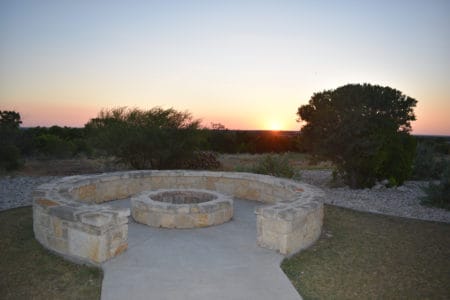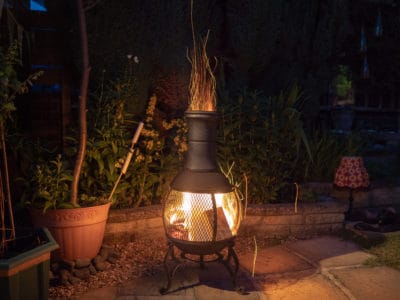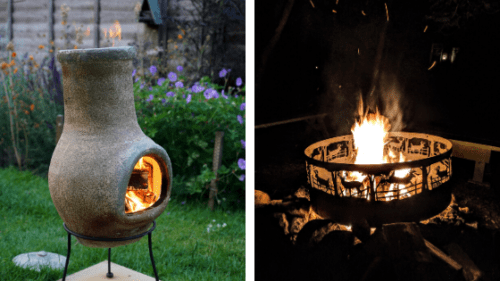A chiminea and a fire pit are two common heat sources for a backyard. While they both fulfill a similar purpose, they are technically not the same. This article will take a look at the differences between a chiminea vs. a fire pit to help readers decide which one is right for them.
Table of Contents
What is a Chiminea?
The word chiminea comes from the the Spanish word “chimenea” that came from the French word cheminée. As you probably guessed, “chiminée” means chimney in French.
A chiminea is a detached outdoor fireplace that is loaded from the front with wood or another fuel source.
The body is round and hollow with a typical half circle opening that is large enough to accommodate standard pieces of firewood. The hollow body is load with wood or another fuel to burn for the fire.
The body connects to a chimney that is typically a few feet tall. This chimney allows the smoke to escape upward similar to an indoor fireplace.
The traditional chiminea material is clay. However, many are now made from cast iron, aluminum, and steel.
What is a Fire Pit?
A fire pit can simply be a hole in the ground that contains the fire. In ancient times, that hole concealed the fire and helped prevent valuable items and land nearby from being set into flames. Today, ground fire pits are still somewhat popular. The below picture is an example of a type of fire pit that has been dug into the ground.

Most people are likely familiar with freestanding fire pits that sit a couple of feet off the ground. They are most commonly round or square and are small enough to move around the yard as needed.
They are often fueled by wood or charcoal. However, some can even operate off of gas such as propane or natural gas.
The below picture is an example of a freestanding fire pit. They can commonly be purchased at stores such as Wal-Mart, Home Depot, Lowe’s, and Amazon. Some of these types of fire pits contain a table on the outdoor edge to hold items such as drinks or food.

Fire pits can also be constructed into the patio as a permanent structure as shown below. These have become a much sought after feature of homes around North America and beyond. These tend to be much more expensive than the previous mentioned fire pits.

Chiminea vs Fire Pit
Outside of the physical differences shown above, let’s take a look at some other areas where the chiminea and fire pit differ and even have some similarities.
Price
There are an enormous selection of chimineas and fire pits available for purchase at a huge range of prices. However, chimeneas tend to be more expensive than freestanding fire pits. It is not uncommon to find chimineas priced well above $200 and even getting into the $500 and above range. While there are certainly fire pits priced around $500 or more, many can be found at $200 or less.
View of Fire
A disadvantage of a chiminea is that it commonly does not allow a 360° view of the fire. In other words, only the flames can be seen through the opening where the wood is insert for many types of chimeneas. The majority of fire pits allow the flames to be seen no matter where people are seated around the fire pit.
You can see the difference in the fire views between the chiminea vs the fire pit in the photo below. If you were seated behind or on the sides of the chiminea, you would not be able to enjoy the visual of the flames. However, the fire pit provides sight of the fire from all angles.

Some chimineas, however, do provide a 360° view of the fire. For example, the one pictured below has wire mesh screening around the body to allow a full view of the flames. If you are thinking about purchasing a chiminea, you should greatly consider the importance of seeing the fire at all angles before you buy.

Fuel Sources
The most common fuel source for both the chiminea and the fire pit is firewood. Other options for both are propane and natural gas when they are equipped to accept these types of fuel. Charcoal is also commonly used. Gel fuel has become another popular choice of fuel in recent years for fire pits. This type of fuel burns clean and does not produce smoke, but it also does not offer an abundance of heat.
Material
As stated previously, clay is the traditional material of chimineas. Clay chimineas often have beautiful paintings or patterns etched into their surface, making them extremely visually appealing to many homeowners. Metal chimineas such as cast iron, steel, cooper, and aluminum are other popular materials that are often extremely durable.
Common free-standing fire pit materials include steel, cooper, cast iron, and stone with tile. Fire pits built into the ground or on a patio are typically built with materials such as fire bricks, pavers, and concrete.
Smoke
One of the many benefits of a chiminea is its ability to direct smoke out of the chimney and away from people standing near it. Think of a chiminea like you would an indoor fireplace. Smoke is never an issue with an indoor fireplace when the flue is open because the smoke travels up and out of the chimney and not into the room.
Smoke from a fire pit can be much more of a nuisance compared to a chiminea because it is allowed to indiscriminately blow up toward the faces of people sitting close. An unlucky person sitting in the wrong seat near the fire pit can routinely get blasted with a face full of smoke.
Storing
Chimineas can be challenging to store because of their bulk, weight, and the height of the chimney. People often cover them with waterproof protective covers instead of moving them to a place like the garage or shed for storage.
Moveable fire pits tend to be much easier to store in comparison to chimineas due to their compact size. A smaller fire pit can easily be stored in the corner of the garage during the winter without taking up much room. However, extra large fit pits can pose similar storage problems as chimeneas.
Heat
Several types of chimineas are only open in the front. This means that heat is only radiated out of the front opening. The areas to the side and rear provide little, if any, heat to people standing nearby. If you are seeking heat from the most angles, go with a fire pit or a chiminea that is open around the whole body.
Conclusion
While we would love to provide you with a definitive answer to if a chiminea vs a fire pit is better, there is no right answer. While the fire pit is the reliable and go-to source for a classic backyard heat source, the chiminea provides a unique but traditional charm. After reading this article, we are confident that you have narrowed down which one is right for your yard.

